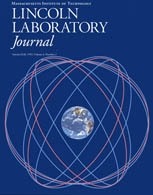Publications
Volume 6, Number 2
 |
|
Integrated Use of GPS and GLONASS in Civil Aviation The combination of signals planned to be available for civil use from the U.S.'s Global Positioning System (GPS) and the former U.S.S.R.'s GLONASS system offers the promise of an accurate and economical sole-means navigation system for civil aviation. An FAA-sponsored program at Lincoln Laboratory has examined the technical issues associated with the integrated use of the two autonomous systems, and has established the level of performance so achievable. LNKnet: Neural Network, Machine-Learning, and Statistical Software for Pattern Classification Pattern-classification and clustering algorithms are key components of modern information processing systems used to perform tasks such as speech and image recognition, printed-character recognition, medical diagnosis, fault detection, process control, and financial decision making. To simplify the task of applying these types of algorithms in new application areas, we have developed LNKnet—a software package that provides access to more than 20 pattern-classification, clustering, and feature-selection algorithms. Included are the most important algorithms from the fields of neural networks, statistics, machine learning, and artificial intelligence. The algorithms can be trained and tested on separate data or tested with automatic cross-validation. LNKnet runs under the UNIX operating system and access to the different algorithms is provided through a graphical point-and-click user interface. Graphical outputs include two-dimensional (2-D) scatter and decision-region plots and 1-D plots of data histograms, classifier outputs, and error rates during training. Parameters of trained classifiers are stored in files from which the parameters can be translated into source-code subroutines (written in the C programming language) that can then be embedded in a user application program. Lincoln Laboratory and other research laboratories have used LNKnet successfully for many diverse applications. An Adaptive-Focusing Algorithm for a Microwave Planar Phased-Array Hyperthermia System We have experimentally investigated the use of adaptive-focusing techniques in the hyperthermia treatment of cancer. Gradient-search adaptive-focusing software developed at Lincoln Laboratory has been implemented on a commercial microwave hyperthermia planar phased-array antenna system at the University of California at San Francisco (UCSF). The system, manufactured by Labthermics Technologies, Inc., consists of 16 independent amplitude/phase-controlled waveguide antenna elements operating at 915 MHz. In the experiments, conducted at UCSF, a method of steepest-ascent gradient-search feedback algorithm was used to control the hyperthermia array phase shifters and focus the transmitted radiation beam at a hypothetical tumor site in a muscle-equivalent sugar/saline liquid phantom. A feedback probe, embedded in the phantom, measured the resulting electric field (E-field) generated by the antenna array. The measured data indicate a significant increase in the focal-region field strength with a rapid convergence of the adaptive-focusing algorithm in 10 to 15 iterations. From the measurements, the maximum useful heating depth in the sugar/saline phantom is estimated for the 915-MHz system at about 3 cm. An Automatic Ship Classification System for ISAR Imagery We have designed and developed an automatic ship classification (ASC) system for classifying potential naval targets from inverse synthetic-aperture radar (ISAR) imagery. Initially, the ASC system was developed for an over-the-horizon targeting application. In the application, an airborne platform with an on-board ISAR sensor transmitted imagery to a host ship carrying the ASC system. Our present focus is on placing the ASC system on board the sensor platform to assist the flight crew in classifying naval vessels. The current ASC system uses both neural network and conventional processing techniques to determine the ship class of a target from ISAR imagery acquired during reconnaissance missions. An Adaptive Clustering Network (ACN) allows a single ship class to be distributed across several categories so that the system develops a degree of invariance to target motion. We have evaluated the ASC system on a limited set of actual ISAR imagery collected during operator training missions and on a larger database of imagery from IBM. Our preliminary results indicate that an operational ASC system with performance levels comparable to human operators can be achieved. From these results, we feel that the ASC system is now ready for a thorough field evaluation on board an ISAR sensor platform. |
|